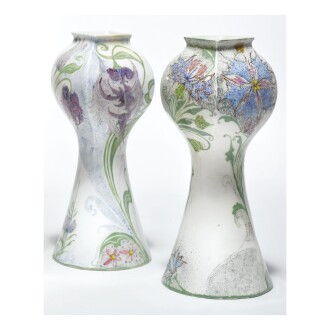S otheby's Design sale is now online, with bidding open now through 31 March at 12:00 PM EDT. The auction features an array of prized objects from the very best designers and collectors of the 20th century, with highlights including a remarkable selection of ceramic works. Below, we take a closer look at ceramic highlights from the sale – scroll down to see more, and be sure to view the digital catalogue for a full listing of lots.
Tiffany Studios
T hough Tiffany Studios was best known for its iconic leaded and blown glass works, the firm experimented in a number of different media. Tiffany’s exploration of pottery was inspired by Louis Comfort Tiffany’s travels through Europe, where he encountered a multitude of ceramics, particularly at the Paris Salons. In classic Tiffany form, nature was muse for the firm’s pottery works. Lots 5 and 6 are interesting examples of Tiffany’s pottery. Lot 5 depicts a number of different types of birds but does so in a more decorative and conventionalized way compared to Tiffany’s more typical naturalistic approach. Both lots are executed with unusual, very rich and vibrant blue glazes.
Joseph Mougin
T
he early work of French ceramicist Joseph Mougin epitomizes the Art Nouveau aesthetic. Working with his brother, Pierre, he translated his fascination with horticulture into naturalistic vegetal forms in ceramic. Like many of his Art Nouveau contemporaries, the female form was a popular form in Mougin’s work as well. This vase depicting bathers is special in that the figures are both pictorial and sculptural, with one figure depicted on the body of the vase, languid and floating on her back, while the other figure who appears to be diving into the pool below makes up the form of the pitcher as its handle. The expressive quality and richness of the glaze of the present lot is highly characteristic of the work of this celebrated Art Nouveau ceramicist.
Rozenburg
R
ozenburg Potter and Porcelain Factory was founded in 1883 in the Hague, Netherlands, and played an important role in bringing Art Nouveau to the region. In 1899, the firm introduced its new “eggshell” porcelain, characterized by the impossibly thin and delicate porcelain walls of the vessels they created. The eggshell porcelain was strengthen by the application of glaze, which was then decorated with stylized subjects from nature. Samuel Schellink, who decorated lots 119 and 122-124, was one of the firm’s master painters. Decorations would be applied to each porcelain work first with pencil and then painted over by one or more painters. The impeccable artistry and delicacy of Rozenburg’s work make them highly treasured objects today.

Georges Jouve
B
efore World War II, Georges Jouve studied art history and sculpture at the famed École Boulle in Paris and went on to work as a theatre set designer. During the war, he was captured, interned in a German camp, and later escaped and sought refuge with relatives living in a potters village in the south of France. There he developed his skills as a ceramicist and after the war he returned to Paris with a new vocation. His highly modern forms and rich glazes epitomized the French mid-century aesthetic. Jouve created vessels in a variety of forms, from boxes to vases to bottles and more, and he was particularly talented at imparting a unique character to each work. In lot 216, the two cylinder vases are applied with a deep blue glaze on the exterior with a black glaze on the interior, imparting a wonderful graphic quality. The pair of yellow vases, lot 217, are characterized by their exuberant color and robust form.

Ruelland
L ike Georges Jouve, husband and wife ceramicist duo Jacques and Dani Ruelland were influential figures in the world of French mid-century ceramics. They met at the École des Beaux-Arts in Paris in the 1950s where Jacques studied painting and Dani studied sculpture. Combining their individual talents, they began producing ceramics together. Their vessel forms range from tall slender bottles to petite and rotund vases, and all are applied with rich glazes. Lots 220 and 221 are from the collection of Marc Jacobs, who displayed vases together to create charming pairings and showcase the variety of forms and glazes.
Schreckengost
J ust a few months after joining Cowan Pottery in 1930, Viktor Schreckengost was randomly assigned the task to design a punch bowl displaying a ''New Yorkish'' theme for a woman in New York City. Unbeknownst to Schreckengost, the woman who commissioned the punch bowl was Eleanor Roosevelt. After receiving Mrs. Roosevelt’s glowing response to the finished product, Cowan subsequently put the punch bowl into production. The iconography decorating the bowl's exterior epitomizes the sights and sounds of New York's Jazz Age. The graphic narrative portrays a ''night on the town'' in New York City, depicting images of dancers, glowing street lamps, a clock that reads ''3:30'' in the morning, the neon signs of Times Square, towering skyscrapers, musical instruments, cocktail goblets and liquor bottles. Schreckengost additionally designed a similar series of Jazz plates.
Natzler
G
ertrud and Otto Natzler, another husband and wife ceramicist duo, were entirely self-taught with their craft. Both were born in Austria, where they met and began working together. Just before World War II, they fled to the United States and set up a ceramics studio in Los Angeles. Gertrud was primarily the potter, while Otto specialized in glazes, perfecting over 2,000 colors and glazing techniques. The group of bowls offered in lot 263 showcases a wonderful variety of glazes and textures.












